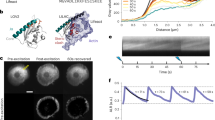Abstract
Profilins belong to a family of small G-actin binding proteins which are thought to assist in F-actin elongation at the leading edge of migrating cells through their interactions with a host of actin-binding proteins including Ena (enabled)/VASP (vasodilator stimulated phosphoprotein). Profilin’s interactions with the major actin regulators have been studied almost exclusively using biochemical methods. Therefore spatiotemporal features of these protein–protein interactions have not been resolved so far. In this paper, we for the first time demonstrate the feasibility of GFP-based fluorescence resonance energy transfer (FRET) technique to detect VASP’s interaction with profilin-1, a ubiquitously expressed member of profilin family of genes. Specifically, we performed acceptor photobleaching FRET in MDA-MB-231 breast cancer cells to show prominent VASP–Pfn1 interaction at the membrane ruffles near the leading edge.





Similar content being viewed by others
References
Bae, Y. H., Z. Ding, L. Zou, A. Wells, F. Gertler, and P. Roy. Loss of profilin-1 expression enhances breast cancer cell motility by Ena/VASP proteins. J. Cell. Physiol. 219(2):354–364, 2009.
Bear, J. E., T. M. Svitkina, M. Krause, D. A. Schafer, J. J. Loureiro, G. A. Strasser, I. V. Maly, O. Y. Chaga, J. A. Cooper, G. G. Borisy, and F. B. Gertler. Antagonism between Ena/VASP proteins and actin filament capping regulates fibroblast motility. Cell 109(4):509–521, 2002.
Buss, F., C. Temm-Grove, S. Henning, and B. M. Jockusch. Distribution of profilin in fibroblasts correlates with the presence of highly dynamic actin filaments. Cell Motil. Cytoskeleton 22:51–61, 1992.
Ding, Z., A. Lambrechts, M. Parepally, and P. Roy. Silencing profilin-1 inhibits endothelial cell proliferation, migration and cord morphogenesis. J. Cell Sci. 119(Pt 19):4127–4137, 2006.
Ding, Z., D. Gau, B. Deasy, A. Wells, and P. Roy. Both actin and polyproline interactions of profilin-1 are required for migration, invasion and capillary morphogenesis of vascular endothelial cells. Exp. Cell Res. 315(17):2963–2973, 2009.
Ferron, F., G. Rebowski, S. H. Lee, and R. Dominguez. Structural basis for the recruitment of profilin-actin complexes during filament elongation by Ena/VASP. EMBO J. 26(21):4597–4606, 2007.
Geese, M., J. J. Loureiro, J. E. Bear, J. Wehland, F. B. Gertler, and A. S. Sechi. Contribution of Ena/VASP proteins to intracellular motility of listeria requires phosphorylation and proline-rich core but not F-actin binding or multimerization. Mol. Biol. Cell 13(7):2383–2396, 2002.
Jockusch, B. M., K. Murk, and M. Rothkegel. The profile of profilins. Rev. Physiol. Biochem. Pharmacol. 159:131–149, 2007.
Karpova, T. S., C. T. Baumann, L. He, X. Wu, A. Grammer, P. Lipsky, G. L. Hager, and J. G. McNally. Fluorescence resonance energy transfer from cyan to yellow fluorescent protein detected by acceptor photobleaching using confocal microscopy and a single laser. J. Microsc. 209(Pt 1):56–70, 2003.
Lanier, L. M., M. A. Gates, W. Witke, A. S. Menzies, A. M. Wehman, J. D. Macklis, D. Kwiatkowski, P. Soriano, and F. B. Gertler. Mena is required for neurulation and commissure formation. Neuron 22(2):313–325, 1999.
Li, Y., S. Grenklo, T. Higgins, and R. Karlsson. The profilin:actin complex localizes to sites of dynamic actin polymerization at the leading edge of migrating cells and pathogen-induced actin tails. Eur. J. Cell Biol. 87(11):893–904, 2008.
Loisel, T. P., R. Boujemaa, D. Pantaloni, and M. F. Carlier. Reconstitution of actin-based motility of Listeria and Shigella using pure proteins. Nature 401:613–616, 1999.
Mimuro, H., T. Suzuki, S. Suetsugu, H. Miki, T. Takenawa, and C. Sasakawa. Profilin is required for sustaining efficient intra- and intercellular spreading of Shigella flexneri. J. Biol. Chem. 275(37):28893–28901, 2000.
Pollard, T. D., and G. G. Borisy. Cellular motility driven by assembly and disassembly of actin filaments. Cell 112:453–465, 2003.
Reinhard, M., K. Giehl, K. Abel, C. Haffner, T. Jarchau, V. Hoppe, B. M. Jockusch, and U. Walter. The proline-rich focal adhesion and microfilament protein VASP is a ligand for profilins. EMBO J. 14(8):1583–1589, 1995.
Rottner, K., B. Behrendt, J. V. Small, and J. Wehland. VASP dynamics during lamellipodia protrusion. Nat. Cell Biol. 1(5):321–322, 1999.
Roy, P., and K. Jacobson. Overexpression of profilin reduces the migration of invasive breast cancer cells. Cell Motil. Cytoskeleton 57(2):84–95, 2004.
Roy, P., Z. Rajfur, P. Pomorski, and K. Jacobson. Microscope-based techniques to study cell adhesion and migration. Nat. Cell Biol. 4(4):E91–E96, 2002.
Sheetz, M. P., D. Felsenfeld, C. G. Galbraith, and D. Choquet. Cell migration as a five-step cycle. Biochem. Soc. Symp. 65:223–243, 1999.
Suetsugu, S., H. miki, and T. Takenawa. The essential role of profilin in the assembly of actin for microspike formation. EMBO J. 17(22):6516–6526, 1998.
Witke, W. The role of profilin complexes in cell motility and other cellular processes. Trends Cell Biol. 14(8):461–469, 2004.
Wittenmayer, N., M. Rothkegel, B. M. Jockusch, and K. Schluter. Functional characterization of green fluorescent protein-profilin fusion proteins. Eur. J. Biochem. 267(16):5247–5246, 2000.
Zou, L., M. Jaramillo, D. Whaley, A. Wells, V. Panchapakesa, T. Das, and P. Roy. Profilin-1 is a negative regulator of mammary carcinoma aggressiveness. Br. J. Cancer 97(10):1361–1371, 2007.
Acknowledgments
This study was funded by a grant from the National Institute of Health (CA108607) to P.R. The authors wish to thank Marion Joy for technical assistance.
Author information
Authors and Affiliations
Corresponding author
Additional information
Associate Editor Edward Guo oversaw the review of this article.
Rights and permissions
About this article
Cite this article
Gau, D., Ding, Z., Baty, C. et al. Fluorescence Resonance Energy Transfer (FRET)-based Detection of Profilin–VASP Interaction. Cel. Mol. Bioeng. 4, 1–8 (2011). https://doi.org/10.1007/s12195-010-0133-z
Received:
Accepted:
Published:
Issue Date:
DOI: https://doi.org/10.1007/s12195-010-0133-z




